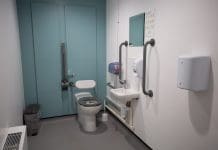As we navigate increasing regulatory demands, growing safety concerns and the urgent need for efficiency, data accuracy in construction is no longer a luxury – it is a necessity, writes Paul Dawson, group technical manager at public sector construction framework provider LHC Procurement Group
The introduction of the Building Safety Act in particular has shone a spotlight on the need for better recordkeeping and data accuracy. It has forced the industry to rethink how we document construction projects and manage ongoing maintenance.
The “golden thread” concept, which focuses on having a clear, traceable line of accountability, is now central to the work of any responsible asset manager.
At LHC, we’ve seen firsthand how vital such records are, not just for legal compliance but for driving quality, safety and cost efficiency throughout a project’s lifecycle.
Unfortunately, the reality on the ground isn’t always clean cut. Many public sector organisations still struggle with data that is incomplete, outdated or poorly managed. In some cases, data isn’t even digital; manually updated spreadsheets are still common.
While these tools are familiar and cheap, they are prone to error and lack the accessibility that digital systems can provide. A digital system enables easy access for all stakeholders and allows for more efficient auditing and compliance tracking.
The case for a digital revolution in asset management
The importance of digital records becomes clear when you consider the full scope of asset management. Whether you’re dealing with high-risk buildings or everyday maintenance, having the correct information available, updated and easily accessible is critical.
When accurate records are kept, everything from compliance checks to repair efficiency improves, saving time, money and ultimately enhancing safety.
Too often, lack of data accuracy leads to unnecessary expenditures and inefficiencies. I’ve encountered numerous situations where contractors have arrived to carry out work only to find that their services weren’t required – simply because the data was wrong. Such errors not only waste valuable time and resources but also delay vital compliance work elsewhere.
When digital records are built properly, from the ground up, they allow asset managers and property teams to efficiently allocate resources, predict future maintenance and respond to issues more proactively.
This, in turn, leads to a significant reduction in reactive maintenance, which tends to be more costly and disruptive. A well maintained digital record also reassures tenants that their properties are being looked after with a long-term view of safety and sustainability, rather than rushed, last-minute repairs.
Building from a solid foundation
The key to successful digital recordkeeping is embedding the practice across every aspect of the project lifecycle.
This doesn’t just apply to the construction phase or high-risk assets; it must become part of the everyday culture. All assets, repairs and compliance checks need to be documented accurately and shared with the necessary parties.
This is particularly crucial when it comes to life safety systems such as fire alarms, or gas and electrical systems.
From our perspective at LHCPG, the importance of creating a robust “golden thread” of information cannot be underestimated.
Whether it’s maintaining fire doors or managing complex heating systems, having that single source of truth across all projects helps avoid miscommunication and ensures that everyone – from contractors to asset managers – is on the same page.
The role of competency and accuracy
Competency is a major factor in how well digital records are maintained. For instance, no single person can be expected to know everything, but they must know where to find reliable, accurate and current data or whom to consult for expertise.
“At LHC, we’ve seen firsthand how vital such records are, not just for legal compliance but for driving quality, safety and cost efficiency throughout a project’s lifecycle.”
When you encounter an issue – whether it’s the installation of a gas boiler or managing complex electrical systems – the solution often lies in ensuring that the correct, most competent person is allocated to the job. This is where good records make a real difference.
However, it’s critical that data isn’t just collected: it must be validated. An inaccurate digital record is more harmful than having no record at all.
One of the biggest challenges we face is ensuring that the data being fed into these systems is both correct and complete. I’ve seen instances where identical electrical test readings have been recorded across multiple properties, which is a clear red flag for inaccurate data. Systems and frameworks can only work if the data they are built on is reliable.
That’s why cleansing data should be a continuous practice embedded into the culture of managing digital records. You can have the best data going, but if it’s transferred across systems, or copied without verification, you risk building a database of uncleaned data, which leaves you back at square one.
The future of data accuracy in construction
Looking ahead, we are seeing the rise of technologies such as AI, which can help analyse patterns, defects and even predict when maintenance will be needed based on historical data.
However, the success of these systems will depend on data accuracy. We can expect a future where QR codes and smart asset tags lead to digital records that are instantly accessible, not just to contractors but to emergency services in the event of a crisis.
But we mustn’t rush into this digital future blindly. It’s vital that we take the time to build data standards that are accurate, comprehensive and universally adopted across the industry. Until we do, the many benefits of AI and other emerging technologies may remain out of reach.
The journey toward robust digital recordkeeping is about more than compliance. It’s about creating a culture of transparency, efficiency and safety.
*Please note that this is a commercial profile.













